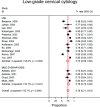Triage of women with equivocal or low-grade cervical cytology results: a meta-analysis of the HPV test positivity rate
- PMID: 19166485
- PMCID: PMC3822872
- DOI: 10.1111/j.1582-4934.2008.00631.x
Triage of women with equivocal or low-grade cervical cytology results: a meta-analysis of the HPV test positivity rate
Abstract
Consistent evidence underlines the utility of human papillomavirus (HPV) DNA testing in the management of women with equivocal cervical cytological abnormalities, but not in case of low-grade lesions. We performed a meta-analysis including studies where the high-risk probe of the Hybrid Capture-II is used to triage these two cytological categories. The triage test-positivity rate reflects the colposcopy referral workload.Data were pooled on the HPV test positivity rate in women with atypical squamous cells of undetermined significance (ASCUS/ASC-US) or low-grade squamous intraepithelial lesions (LSIL), derived from different cytological classification systems. The meta-analysis was restricted to studies, published between 1991 and 2007. A random-effect model was applied for meta-analytical pooling and the influence of covariates on the HPV positivity rate was analyzed by meta-regression. The variation by age was assessed within individual studies since age strata were not defined uniformly. On an average, 43% (95% CI: 40-46%) of women with ASCUS/ASC-US were high-risk HPV positive (range 23-74%). In women with LSIL, the pooled positivity rate was 76% (95% CI: 71-81%; range 55-89%). In spite of considerable inter-study heterogeneity, the difference in HPV positivity between the two triage groups was large and highly significant: 32% (95% CI: 27-38%). HPV rates dropped tremendously as age and cutoffs of test positivity increased. Other factors (cytological classification system, country, continent, collection method and year of publication) had no statistically significant impact, except in LSIL triage where HPV positivity was significantly lower in European compared to American studies. Women with LSIL, especially younger women, have high HPV positivity rates suggesting limited utility of reflex HPV triaging these cases. Research is needed to identify more specific methods to triage women with low-grade squamous cervical lesions.
Figures




References
-
- Melnikow J, Nuovo J, Willan AR, Chan BK, Howell LP. Natural History of cervical squamous intraepithelial lesions: a meta-analysis. Obstet Gynecol. 1998;92:727–35. - PubMed
-
- Holowaty P, Miller AB, Rohan T, To T. Natural History of Dysplasia of the Uterine Cervix. J Natl Cancer Inst. 1999;91:252–8. - PubMed
-
- Wright TC, Cox JT, Massad LS, Wilkinson EJ. 2001 Consensus guidelines for the management of women with cervical cyto-logical abnormalities. JAMA. 2002;287:2120–9. - PubMed
-
- Arbyn M, Buntinx F, Van Ranst M, Paraskevaidis E, Martin-Hirsch P, Dillner J. Virologic versus cytologic triage of women with equivocal Pap smears: a meta-analysis of the accuracy to detect high-grade intraepithelial neoplasia. J Natl Cancer Inst. 2004;96:280–93. - PubMed
-
- Arbyn M, Dillner J, Van Ranst M, Buntinx F, Martin-Hirsch P, Paraskevaidis E. Re: Have we resolved how to triage equivocal cervical cytology? J Natl Cancer Inst. 2004;96:1401–2. - PubMed
Publication types
MeSH terms
LinkOut - more resources
Full Text Sources
Other Literature Sources
Medical
Miscellaneous

